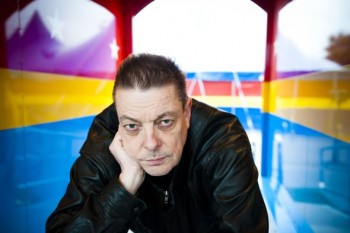The edge of wordlessness
1 March 2012 | Authors, Reviews

Harri Nordell. Photo: Veikko Somerpuro
The poems of Harri Nordell are a mystery to me. Each time I open one of his books, my reading begins afresh. I have analysed and translated his poems, but the texts have still not become familiar. I have not begun to comprehend them. They always speak to me as if for the first time.
I could not wish for a greater gift from a poem. These poems create a special state of being; I could call it not-knowing or marvelling. I feel I am involved in an unfolding event.
Nordell’s poems open me up, but I am unable to prise them open. I do not want to interpret cryptic expressions, or seek out more explicit meanings for them. I would not wish to write on top of these poems, to mute silence with superfluous words.
The imagery of the poems is diverse: traditional at times, highly radical at others. Despite their use of imagery, the texts resist a metaphorical reading, whereby interpretation uncovers the ‘real’ meaning behind an image. The poems do denote something, but not anything that can be named in simpler terms. There is secrecy in the saying.
Nordell’s poems cut across different times, yet their moment is now. A Nordell poem arrives softly yet forcefully. Mere shreds come to the surface, yet the work brings aeons with it. The poem is placeless, in a vacuum. Yet each poem engages with the world.
The modern poem has often been compared to a sculpture. The comparison emphasises the object-like quality of a poem: density of meaning, inward-directed power, sharply delineated contours. The characterisation befits Nordell in that, when scrutinising a sparse poem from different angles, one keeps discovering new meanings, and the relationships between these meanings create tension. For example, the way Nordell blurs the distinction between parts of speech makes micro-reading so rewarding that the poem’s references to the exterior world may not be the main focus of interpretation.
Even so, I think that the effect of Nordell’s work is based on how it extends beyond itself, into ‘reality’. There is something visionary in this, maybe even dramatic; the emergence of the world appears as a kind of birth in which words play an active role. The words do not merely weave into each other, they evoke the world.
In terms of modernist self-sufficiency, a Nordell poem is not complete. It does not close itself off. In the world of sculpture, the works of Alberto Giacometti, which shimmer endlessly, seeking their own contours, provides a point of comparison. This kind of movement intensifies with the progress of Nordell’s work: the innovative narrativity of Valkoinen kirja (‘The white book’, 2006)) departs even further from rock-like solidity. The weight of the single word reduces, the poem’s edge dissolves. The poem breathes in and out.
The ‘I’ of the poem often says ‘you’. The ‘I’ addresses another person, a beloved, but there are much broader implications to this act. The ‘I’ is a function of the ‘you’, and vice versa; and in that sense always incomplete. One’s fundamental relationship with the world entails addressing ‘you’ and being addressed. Addressing ‘you’ signifies participation in the unfolding and emergence of things here and now; just as light creates the world by making it visible.
There are no finished words. The dialogic ‘I – you’ relationship introduces something tentative or sketchy into the poems. Although the texts have been honed to the point of minimalism, the gesture of crystallisation, of finalisation, is missing. They call out to you.
I once stood in front of a Mark Rothko painting. All of a sudden, the painting became a window. I felt I was looking through it, into another world.
Experiencing Nordell’s poems is similar. The most daring leap they make is to reach the outer limit, the edge of ineffability.
The edge of the sacred, the transcendental? The old labels are not good enough. The language has to be constructed anew. It is constructed here, in the actual event of naming, and not in the familiar, established manner. This despite the fact that the whole train of tradition is trailing behind. (And how lightly it trails!) Nordell’s poems are not riddles I could try to solve. They point at something outside themselves, but at what? If you could say it in other words, there would be no poems. The works make me listen to another way of saying things, one that differs from the one I regard as my language.
The potential ‘obscurity’ of the poems does not constitute glued-on aesthetics, but is an inevitable consequence of what they are striving at. The attempt to say, the tough battle the poems wage over naming, is born from an encounter with something outside the known and familiar.
In this respect, Nordell is a Hermetist, a scion of the mythical Hermes Trimegistos and of Paul Celan. But ‘hermetic’ not in the sense of air-tight or impenetrable. In some incomprehensible manner, the Nordell poem becomes a window; we look through it.
Translated by Emily Jeremiah and Fleur Jeremiah
This is an edited version of Tarja Roinila’s ‘Afterword’ to Harri Nordell’s selected poems, Sanaliekki äänettömyydessä. Valitut runot 1980–2006 (‘A word-flame in silence. Selected poems 1980–2006’, WSOY, 2011). See also Sound and meaning, an essay by Tarja Roinila on translating poetry, including Nordell’s
Tags: poetry
No comments for this entry yet
Leave a comment
Also by Tarja Roinila
Sound and meaning - 20 January 2012
The forest, everything - 31 March 1998
-
About the writer
Tarja Roinila (born 1964) is a writer and translator who lives in Helsinki. She translates from German, Spanish and French. Together with Jukka Koskelainen she published an anthology of contemporary Spanish poetry in 2008, entitled Katu kadulta taivaaseen (‘Street by street to heaven’).
© Writers and translators. Anyone wishing to make use of material published on this website should apply to the Editors.
